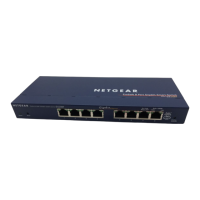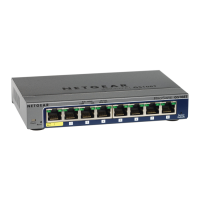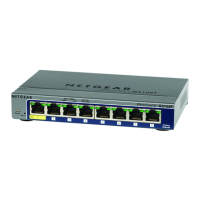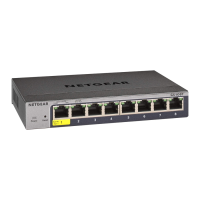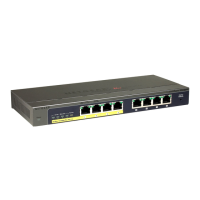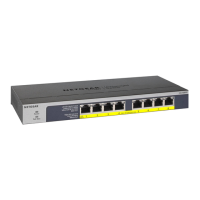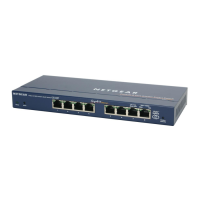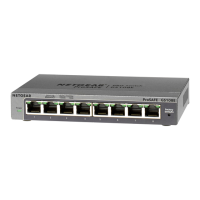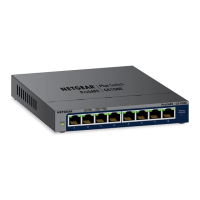Do you have a question about the NETGEAR GS108Tv3 and is the answer not in the manual?
Explains the available management options: local browser interface, NETGEAR Insight app, and Insight Cloud portal.
Describes how to access and manage the switch using its web-based local browser interface.
Guides the user through registering the switch with a NETGEAR account for full access.
Details how to switch between management modes, such as local browser interface and NETGEAR Insight.
Details configuring IPv4 network information and VLAN settings for the local browser interface.
Covers configuring the switch's date and time settings, including manual and SNTP methods.
Details how to configure time synchronization using SNTP and global SNTP settings.
Guides on configuring SNTP servers for accurate network device clock time synchronization.
Covers configuring Denial of Service (DoS) settings to classify and block specific types of DoS attacks.
Describes how to configure global and per-port Power over Ethernet (PoE) settings.
Explains how to configure global Power over Ethernet (PoE) settings for the switch.
Details how to configure individual PoE port settings, including power mode and priority.
Covers configuration of SNMP settings for SNMPv1/v2 and SNMPv3, including groups, users, and traps.
Introduces DHCP snooping as a security feature for filtering untrusted DHCP messages.
Covers defining multiple timer schedules for PoE power delivery to attached Powered Devices (PDs).
Details viewing, configuring, and monitoring physical port information and maximum frame size.
Explains how to combine multiple Ethernet links into a single logical link for fault tolerance and load sharing.
Introduces Virtual LAN (VLAN) support for segmenting networks and improving performance and security.
Guides on assigning ports and LAGs to VLANs, specifying tagged or untagged membership.
Covers defining filtering criteria for untagged packets based on source MAC address for VLAN assignment.
Explains how to define filtering criteria for untagged packets based on protocol for VLAN assignment.
Covers configuring Auto-VoIP feature for classifying and prioritizing voice packets for better Quality of Service (QoS).
Introduces Spanning Tree Protocol (STP) for network loop elimination and provides information on configuring global STP settings.
Covers configuring Multiple Spanning Tree (MST) instances on the switch.
Introduces IGMP snooping for intelligently forwarding IPv4 multicast traffic.
Introduces Multicast Listener Discovery (MLD) snooping for IPv6 networks.
Covers viewing, searching, and managing the switch's MAC address table entries.
Explains how to enable and configure Layer 2 loop protection per port or globally to detect and prevent network loops.
Details enabling and configuring routing settings, including routing on VLANs.
Covers configuring ports to support VLANs and routing, allowing traffic on a VLAN to be treated as router port traffic.
Guides on using the VLAN Static Routing Wizard to create and configure VLAN routing interfaces.
Covers collecting routes from static, local, and dynamic sources and viewing the routing table.
Details configuring Class of Service (CoS) queueing features for switch queueing behavior.
Guides on configuring global Class of Service (CoS) trust mode settings applied to all interfaces.
Details configuring CoS trust mode and interface shaping rate for specific interfaces.
Explains how to define egress queue settings, bandwidth, depth, and scheduling for each port.
Guides on mapping Ethernet frame 802.1p priority class values to internal traffic classes (queues).
Details mapping internal traffic classes to Differentiated Services Code Point (DSCP) values.
Introduces Differentiated Services (DiffServ) support for traffic classification and QoS treatment.
Details adding, renaming, or deleting DiffServ classes and defining match criteria.
Details creating and configuring an IPv6 DiffServ class with specified match criteria.
Explains how to associate classes with policies for QoS treatment.
Guides on changing the local device password for the admin user of the switch's browser interface.
Covers configuring RADIUS servers for centralized authentication and access control.
Details adding information about one or more RADIUS servers on the network.
Guides on adding a primary RADIUS authentication server and viewing/resetting statistics.
Guides on viewing and configuring settings for a RADIUS accounting server.
Covers configuring global TACACS+ settings for communication between switch and TACACS+ server.
Details configuring global TACACS+ settings for switch and TACACS+ server communication.
Guides on configuring up to three TACACS+ servers for switch communication.
Details specifying authentication methods to validate switch or port access for admin users.
Details defining the IEEE 802.1X authentication method for the default list.
Explains configuring global settings for HTTP and HTTPS access to the switch's local browser interface.
Guides on configuring HTTP access settings on the switch.
Details configuring HTTPS access settings for secure communication with the switch.
Covers configuring access control profiles and rules for managing access to switch resources.
Guides on setting up a security access profile and associating access rule configurations.
Details adding security access rules to an existing access profile.
Explains how to activate a configured access profile to enforce security rules.
Covers enabling and configuring port access control using 802.1X on physical ports.
Guides on configuring global port access control settings for 802.1X features.
Details enabling and configuring 802.1X port access control on one or more physical ports.
Guides on configuring 802.1X settings for a specific port.
Covers configuring MAC filters, storm control, port security, and protected port settings.
Details creating MAC filters to limit traffic allowed into and out of specified switch ports.
Covers configuring storm control settings to prevent network overload from excessive broadcast, multicast, or unicast traffic.
Details configuring global storm control settings that apply to all ports.
Explains how to lock ports on the switch to allow only specified source MAC addresses.
Details configuring the global port security mode for the switch.
Guides on defining allowed MAC addresses for a port using dynamic or static locking.
Introduces Access Control Lists (ACLs) for ensuring authorized access and controlling traffic flow.
Guides on creating an ACL ID, defining rules, and applying the ACL to interfaces.
Explains how to use the ACL Wizard to quickly create a simple ACL and apply it to selected ports.
Details creating MAC ACLs consisting of rules matched sequentially against packets.
Covers defining rules for MAC-based ACLs to specify traffic forwarding or discarding criteria.
Covers binding ACLs to interfaces and LAGs, applying rules to the selected interface.
Introduces IPv4 ACLs, consisting of rules matched sequentially against packets for traffic control.
Guides on defining rules for basic IPv4 ACLs to specify traffic forwarding or discarding criteria.
Guides on defining rules for extended IPv4 ACLs to specify traffic matching criteria.
Introduces IPv6 ACLs, consisting of rules matched sequentially against packets for traffic control.
Guides on defining rules for IPv6 ACLs to specify traffic matching criteria.
Covers binding IP ACLs (IPv4, extended IPv4, IPv6) to interfaces and LAGs.
Covers associating MAC, IPv4, or IPv6 ACLs with a VLAN and applying them to interfaces.
Covers viewing port and switch statistics and performing cable tests.
Explains how to view detailed statistical information about the traffic processed by the switch.
Guides on viewing a summary of per-port traffic statistics on the switch.
Details viewing a variety of per-port traffic statistics and managing counters.
Guides on testing cables connected to switch ports and viewing cable status and length.
Covers generating, storing, and forwarding system messages, faults, and configuration changes.
Details selecting switch ports to mirror network traffic for analysis by a network analyzer.
Explains how to reboot the switch from the local browser interface.
Guides on resetting the system configuration to factory default values, losing all changes.
Covers downloading system files from a remote system to the switch using TFTP or HTTP.
Covers sending pings, traceroutes, and performing memory dumps for diagnostics.
Explains how to enable remote diagnostic access to the switch for technical support.
Explains Access Control Lists (ACLs) for ensuring authorized access and controlling traffic flow.
Explains Differentiated Services (DiffServ) support for traffic classification and QoS treatment.
Explains port-based network access control using 802.1X authentication for devices attached to LAN ports.
Shows a configuration example for enabling 802.1X-based authentication on switch ports using a RADIUS server.
Explains the available management options: local browser interface, NETGEAR Insight app, and Insight Cloud portal.
Describes how to access and manage the switch using its web-based local browser interface.
Guides the user through registering the switch with a NETGEAR account for full access.
Details how to switch between management modes, such as local browser interface and NETGEAR Insight.
Details configuring IPv4 network information and VLAN settings for the local browser interface.
Covers configuring the switch's date and time settings, including manual and SNTP methods.
Details how to configure time synchronization using SNTP and global SNTP settings.
Guides on configuring SNTP servers for accurate network device clock time synchronization.
Covers configuring Denial of Service (DoS) settings to classify and block specific types of DoS attacks.
Describes how to configure global and per-port Power over Ethernet (PoE) settings.
Explains how to configure global Power over Ethernet (PoE) settings for the switch.
Details how to configure individual PoE port settings, including power mode and priority.
Covers configuration of SNMP settings for SNMPv1/v2 and SNMPv3, including groups, users, and traps.
Introduces DHCP snooping as a security feature for filtering untrusted DHCP messages.
Covers defining multiple timer schedules for PoE power delivery to attached Powered Devices (PDs).
Details viewing, configuring, and monitoring physical port information and maximum frame size.
Explains how to combine multiple Ethernet links into a single logical link for fault tolerance and load sharing.
Introduces Virtual LAN (VLAN) support for segmenting networks and improving performance and security.
Guides on assigning ports and LAGs to VLANs, specifying tagged or untagged membership.
Covers defining filtering criteria for untagged packets based on source MAC address for VLAN assignment.
Explains how to define filtering criteria for untagged packets based on protocol for VLAN assignment.
Covers configuring Auto-VoIP feature for classifying and prioritizing voice packets for better Quality of Service (QoS).
Introduces Spanning Tree Protocol (STP) for network loop elimination and provides information on configuring global STP settings.
Covers configuring Multiple Spanning Tree (MST) instances on the switch.
Introduces IGMP snooping for intelligently forwarding IPv4 multicast traffic.
Introduces Multicast Listener Discovery (MLD) snooping for IPv6 networks.
Covers viewing, searching, and managing the switch's MAC address table entries.
Explains how to enable and configure Layer 2 loop protection per port or globally to detect and prevent network loops.
Details enabling and configuring routing settings, including routing on VLANs.
Covers configuring ports to support VLANs and routing, allowing traffic on a VLAN to be treated as router port traffic.
Guides on using the VLAN Static Routing Wizard to create and configure VLAN routing interfaces.
Covers collecting routes from static, local, and dynamic sources and viewing the routing table.
Details configuring Class of Service (CoS) queueing features for switch queueing behavior.
Guides on configuring global Class of Service (CoS) trust mode settings applied to all interfaces.
Details configuring CoS trust mode and interface shaping rate for specific interfaces.
Explains how to define egress queue settings, bandwidth, depth, and scheduling for each port.
Guides on mapping Ethernet frame 802.1p priority class values to internal traffic classes (queues).
Details mapping internal traffic classes to Differentiated Services Code Point (DSCP) values.
Introduces Differentiated Services (DiffServ) support for traffic classification and QoS treatment.
Details adding, renaming, or deleting DiffServ classes and defining match criteria.
Details creating and configuring an IPv6 DiffServ class with specified match criteria.
Explains how to associate classes with policies for QoS treatment.
Guides on changing the local device password for the admin user of the switch's browser interface.
Covers configuring RADIUS servers for centralized authentication and access control.
Details adding information about one or more RADIUS servers on the network.
Guides on adding a primary RADIUS authentication server and viewing/resetting statistics.
Guides on viewing and configuring settings for a RADIUS accounting server.
Covers configuring global TACACS+ settings for communication between switch and TACACS+ server.
Details configuring global TACACS+ settings for switch and TACACS+ server communication.
Guides on configuring up to three TACACS+ servers for switch communication.
Details specifying authentication methods to validate switch or port access for admin users.
Details defining the IEEE 802.1X authentication method for the default list.
Explains configuring global settings for HTTP and HTTPS access to the switch's local browser interface.
Guides on configuring HTTP access settings on the switch.
Details configuring HTTPS access settings for secure communication with the switch.
Covers configuring access control profiles and rules for managing access to switch resources.
Guides on setting up a security access profile and associating access rule configurations.
Details adding security access rules to an existing access profile.
Explains how to activate a configured access profile to enforce security rules.
Covers enabling and configuring port access control using 802.1X on physical ports.
Guides on configuring global port access control settings for 802.1X features.
Details enabling and configuring 802.1X port access control on one or more physical ports.
Guides on configuring 802.1X settings for a specific port.
Covers configuring MAC filters, storm control, port security, and protected port settings.
Details creating MAC filters to limit traffic allowed into and out of specified switch ports.
Covers configuring storm control settings to prevent network overload from excessive broadcast, multicast, or unicast traffic.
Details configuring global storm control settings that apply to all ports.
Explains how to lock ports on the switch to allow only specified source MAC addresses.
Details configuring the global port security mode for the switch.
Guides on defining allowed MAC addresses for a port using dynamic or static locking.
Introduces Access Control Lists (ACLs) for ensuring authorized access and controlling traffic flow.
Guides on creating an ACL ID, defining rules, and applying the ACL to interfaces.
Explains how to use the ACL Wizard to quickly create a simple ACL and apply it to selected ports.
Details creating MAC ACLs consisting of rules matched sequentially against packets.
Covers defining rules for MAC-based ACLs to specify traffic forwarding or discarding criteria.
Covers binding ACLs to interfaces and LAGs, applying rules to the selected interface.
Introduces IPv4 ACLs, consisting of rules matched sequentially against packets for traffic control.
Guides on defining rules for basic IPv4 ACLs to specify traffic forwarding or discarding criteria.
Guides on defining rules for extended IPv4 ACLs to specify traffic matching criteria.
Introduces IPv6 ACLs, consisting of rules matched sequentially against packets for traffic control.
Guides on defining rules for IPv6 ACLs to specify traffic matching criteria.
Covers binding IP ACLs (IPv4, extended IPv4, IPv6) to interfaces and LAGs.
Covers associating MAC, IPv4, or IPv6 ACLs with a VLAN and applying them to interfaces.
Covers viewing port and switch statistics and performing cable tests.
Explains how to view detailed statistical information about the traffic processed by the switch.
Guides on viewing a summary of per-port traffic statistics on the switch.
Details viewing a variety of per-port traffic statistics and managing counters.
Guides on testing cables connected to switch ports and viewing cable status and length.
Covers generating, storing, and forwarding system messages, faults, and configuration changes.
Details selecting switch ports to mirror network traffic for analysis by a network analyzer.
Explains how to reboot the switch from the local browser interface.
Guides on resetting the system configuration to factory default values, losing all changes.
Covers downloading system files from a remote system to the switch using TFTP or HTTP.
Covers sending pings, traceroutes, and performing memory dumps for diagnostics.
Explains how to enable remote diagnostic access to the switch for technical support.
Explains Access Control Lists (ACLs) for ensuring authorized access and controlling traffic flow.
Explains Differentiated Services (DiffServ) support for traffic classification and QoS treatment.
Explains port-based network access control using 802.1X authentication for devices attached to LAN ports.
Shows a configuration example for enabling 802.1X-based authentication on switch ports using a RADIUS server.
| Multicast support | Yes |
|---|---|
| IPv4 multicast entries | 32 |
| Number of multicast groups filtered | 256 |
| Switch type | Managed |
| Switch layer | L2 |
| Data link protocols | Ethernet, Fast Ethernet, Gigabit Ethernet |
| Supported network protocols | HTTP, HTTPS |
| Power connector | DC-in jack |
| Installed SFP modules quantity | - |
| Basic switching RJ-45 Ethernet ports type | Gigabit Ethernet (10/100/1000) |
| Basic switching RJ-45 Ethernet ports quantity | 8 |
| Stackable | No |
| Certification | CE, FCC, VCCI Class B, C-Tick |
| Product color | Gray |
| LED indicators | Activity, LAN, Link, PoE, Power, Speed |
| Number of VLANs | 64 |
| Networking standards | IEEE 802.3ad, IEEE 802.3af, IEEE 802.3at, IEEE 802.3az, IEEE 802.3x |
| Copper ethernet cabling technology | 10BASE-T, 100BASE-TX, 1000BASE-TX |
| Memory type | RAM |
| Flash memory | 32 MB |
| Internal memory | 128 MB |
| Processor frequency | 500 MHz |
| Mean time between failures (MTBF) | 2388657 h |
| MAC address table | 8000 entries |
| Packet buffer memory | 0.5 MB |
| Heat dissipation | 18.66 BTU/h |
| Operating altitude | 0 - 3000 m |
| Storage temperature (T-T) | -20 - 70 °C |
| Operating temperature (T-T) | 0 - 40 °C |
| Operating relative humidity (H-H) | 0 - 95 % |
| DHCP features | DHCP client |
| Security algorithms | 802.1x RADIUS |
| Access Control List (ACL) IPv6 entries | 100 |
| Input current | 1.25 A |
| AC input voltage | 100 - 240 V |
| DC input voltage | 54 V |
| AC input frequency | 50 - 60 Hz |
| Power consumption (max) | 5.5 W |
| Package type | Box |
| Package depth | 270 mm |
| Package width | 226 mm |
| Package height | 64 mm |
| Package weight | 780 g |
| Master (outer) case width | 214 mm |
| Master (outer) case height | 312 mm |
| Master (outer) case length | 474 mm |
| Master (outer) case weight | 5490 g |
| Harmonized System (HS) code | 85176990 |
| Quantity per master (outer) case | 6 pc(s) |
| Depth | 101 mm |
|---|---|
| Width | 158 mm |
| Height | 27 mm |
| Weight | 43000 g |

